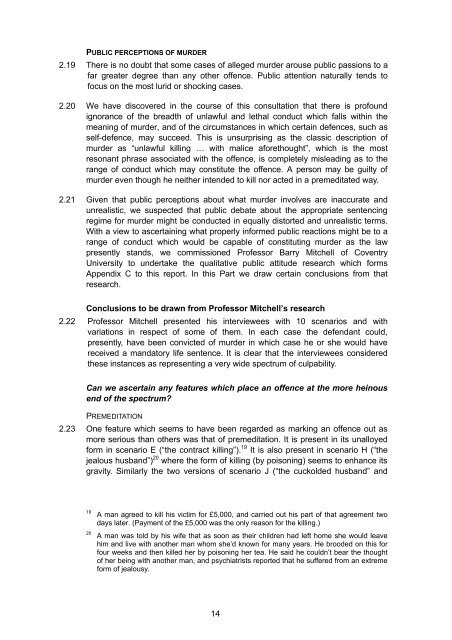lc290 Partial Defences to Murder report - Law Commission
lc290 Partial Defences to Murder report - Law Commission
lc290 Partial Defences to Murder report - Law Commission
You also want an ePaper? Increase the reach of your titles
YUMPU automatically turns print PDFs into web optimized ePapers that Google loves.
PUBLIC PERCEPTIONS OF MURDER<br />
2.19 There is no doubt that some cases of alleged murder arouse public passions <strong>to</strong> a<br />
far greater degree than any other offence. Public attention naturally tends <strong>to</strong><br />
focus on the most lurid or shocking cases.<br />
2.20 We have discovered in the course of this consultation that there is profound<br />
ignorance of the breadth of unlawful and lethal conduct which falls within the<br />
meaning of murder, and of the circumstances in which certain defences, such as<br />
self-defence, may succeed. This is unsurprising as the classic description of<br />
murder as “unlawful killing … with malice aforethought”, which is the most<br />
resonant phrase associated with the offence, is completely misleading as <strong>to</strong> the<br />
range of conduct which may constitute the offence. A person may be guilty of<br />
murder even though he neither intended <strong>to</strong> kill nor acted in a premeditated way.<br />
2.21 Given that public perceptions about what murder involves are inaccurate and<br />
unrealistic, we suspected that public debate about the appropriate sentencing<br />
regime for murder might be conducted in equally dis<strong>to</strong>rted and unrealistic terms.<br />
With a view <strong>to</strong> ascertaining what properly informed public reactions might be <strong>to</strong> a<br />
range of conduct which would be capable of constituting murder as the law<br />
presently stands, we commissioned Professor Barry Mitchell of Coventry<br />
University <strong>to</strong> undertake the qualitative public attitude research which forms<br />
Appendix C <strong>to</strong> this <strong>report</strong>. In this Part we draw certain conclusions from that<br />
research.<br />
Conclusions <strong>to</strong> be drawn from Professor Mitchell’s research<br />
2.22 Professor Mitchell presented his interviewees with 10 scenarios and with<br />
variations in respect of some of them. In each case the defendant could,<br />
presently, have been convicted of murder in which case he or she would have<br />
received a manda<strong>to</strong>ry life sentence. It is clear that the interviewees considered<br />
these instances as representing a very wide spectrum of culpability.<br />
Can we ascertain any features which place an offence at the more heinous<br />
end of the spectrum?<br />
PREMEDITATION<br />
2.23 One feature which seems <strong>to</strong> have been regarded as marking an offence out as<br />
more serious than others was that of premeditation. It is present in its unalloyed<br />
form in scenario E (“the contract killing”). 19 It is also present in scenario H (“the<br />
jealous husband”) 20 where the form of killing (by poisoning) seems <strong>to</strong> enhance its<br />
gravity. Similarly the two versions of scenario J (“the cuckolded husband” and<br />
19 A man agreed <strong>to</strong> kill his victim for £5,000, and carried out his part of that agreement two<br />
days later. (Payment of the £5,000 was the only reason for the killing.)<br />
20 A man was <strong>to</strong>ld by his wife that as soon as their children had left home she would leave<br />
him and live with another man whom she’d known for many years. He brooded on this for<br />
four weeks and then killed her by poisoning her tea. He said he couldn’t bear the thought<br />
of her being with another man, and psychiatrists <strong>report</strong>ed that he suffered from an extreme<br />
form of jealousy.<br />
14

















